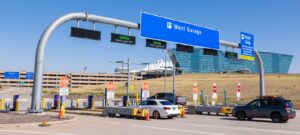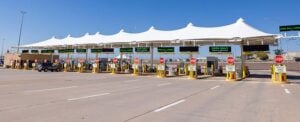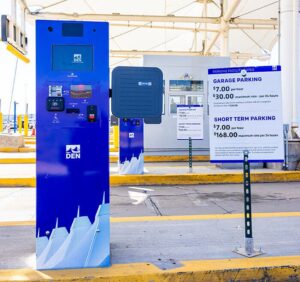Denver International Airport completely revamps its gated parking equipment in only three weeks
By Jay Landers
Among the largest and busiest airports in the United States, the Denver International Airport (DEN), in Denver, Colorado, requires a smoothly functioning parking process to ensure the timely comings and goings of the tens of thousands of vehicles that visit it each day.
In early August, the parking and electric vehicle charging technology provider Flash inked a deal with the airport’s owner — the City and County of Denver — to provide the airport with new parking access and revenue control system (PARCS) equipment. In slightly more than 3 weeks, Flash completed the installation of its equipment across 144 lanes serving the airport’s nine public and employee parking garages and lots.
Heavy volumes
Depending on the time of year, the Denver airport typically accommodates between 25,000 and 28,000 vehicle entries and exits per day, said Mark Nagel, the senior vice president of parking and transportation services for the City and County of Denver’s Department of Aviation.
With 2 public garages, 5 public parking lots, and 2 employee parking lots, the airport manages a total of 51,700 parking spaces. To keep track of vehicles as they enter and exit the facility, the airport uses license plate recognition (LPR) technology on 97 lanes and automatic vehicle identification (AVI) technology on 49 lanes. To accept payments as vehicles exit, the airport uses 137 kiosks.
Given the large numbers of daily visitors to the airport, “those machines are getting a workout,” Nagel said. The high traffic volumes also mean the airport depends heavily on the different forms of equipment. “If there is any glitch in the system or the hardware, it can cause significant backups,” he said.

PHOTOS COURTESY OF DENVER INTERNATIONAL AIRPORT
Prior problems
As part of its recent upgrade, the Denver airport removed the existing PARCS equipment that had been installed by parking management solutions provider Designa in 2019 as part of a 5-year contract that expired on August 31, 2024. This equipment included LPR systems, entry and exit gates, AVI antennas and readers, and proximity card readers.
The airport opted to replace the existing PARCS technology and its associated equipment because of various “systems deficits” associated with the Designa products, Nagel said. These deficits caused a “great amount of rework from not only my team’s standpoint, but also our business technology team’s standpoint,” he said.
Among the issues that the airport had to contend with, according to Nagel, were poor-quality readings from the LPR systems, unreliable internet backup, jammed tickets, and tickets that faded over time and were then hard to read upon exit. The ticket problems, in particular, “always created a backup at the exits,” Nagel noted.
Receipts were a particular problem, Nagel said. “Every time a passenger requested a receipt, usually the receipt window timed out,” he said. “It was always difficult for our customers to get a receipt.”
Designa demurs
For its part, Designa remains “thankful for our time in Denver,” said Brett Winslow, the company’s CEO. “Anytime you're given the opportunity to work with a major airport, it's an amazing opportunity.”

Noting that Denver had used the same PARCS system for more than 15 years before switching to Designa, Winslow attributed some of the inevitable problems to growing pains. Regarding the allegation of unreliable internet backup, Winslow maintained that the “network and internet access were DEN’s responsibility.”
As for problems with LPR readings, Winslow noted that LPR technology from 5 years ago cannot be compared to today’s much more sophisticated systems. “The majority of LPR issues at DEN were caused by environmental factors such as lighting conditions and weather — it snows and rains a lot in Denver — as well as license plates obscured by bike racks, trailers, and the like,” Winslow said. “Older cameras could not accommodate for these differences. We have that technology today.”
The ticket problems resulted not from Designa’s equipment but from the “generic ribbons” that were purchased by the parking operator and “would dry out faster than” the higher-quality ribbons recommended by Designa, Winslow said. In such cases, the “printing would not show up very well on the tickets,” he noted.
Meanwhile, the difficulties that some customers had obtaining receipts most likely resulted from the “operator not replacing receipt paper when it ran out or clearing a receipt jam from a printer in a timely fashion,” Winslow said. “Receipt jams were almost always caused by customers impatiently pulling on the receipt as the printer issued it. This would pull on the spooled receipt paper and jam the machines.”
Happy with HaaS
Rather than issuing its own request for proposals (RFP), the Denver airport opted to use an existing PARCS RFP that was available through the cooperative purchasing organization Omnia Partners. As it happened, the two vendors that Omnia had awarded the contract to were Designa and Flash. Given Denver’s previous problems with Designa, "we chose Flash to start talking about a contract,” Nagel said.
Entered into this past August by Denver and Flash, the 5-year contract includes the option for two 1-year extensions and limits the airport’s maximum liability during the full 7-year period to $21.6 million, Nagel said. Although a significant sum, this amount is “actually a million [dollars] cheaper a year from our previous contract with Designa,” he noted.
A key aspect of the agreement with Flash is that it includes an approach known as hardware as a service (HaaS), wherein the company will replace its equipment at the airport whenever it brings an upgraded model to market, Nagel said. The same holds true for software upgrades. “We get the latest hardware and we get the latest software without any additional costs,” he said.
The installation

For its part, Flash began preparing for the installation of its equipment at the Denver airport well before the contract had been signed in early August. During June and July, the company conducted site visits to ascertain how best to proceed. “They did a lot of work behind the scenes, Nagel said. “They had made sure that they were ready to go when we needed the installation to happen.”
The site visits helped Flash to put together an action plan for removing the existing equipment and installing the new technology as expeditiously as possible, a plan that included various “out-of-the-box solutions,” said Casey Ackman, Flash’s vice president of implementation. Along with staging and configuring as much as possible the necessary equipment at its warehouse in Austin, Texas, Flash “completed a lot of tasks that we could typically do in the field that made this deploy a lot faster,” Ackman said.
Ultimately, the installation included replacing 137 payment kiosks and outfitting 97 LPR lanes and 49 AVI lanes in a mere 22 days. The pace at which the installation was conducted was most impressive, Ackman said. “Normally in the industry, a company will do one to two lanes a day,” he said. “Our goal was six lanes a day. I think we ended up averaging six-and-a-half lanes a day.”
Performance improvements
The new equipment has delivered a “better customer experience for our customers,” Nagel said. “Since we've had the equipment installed, we have had streamlined exits,” Nagel said.
“We have seen significant improvement of reliability of the employees being able to access their lots with the new license plate readers and also being able to exit the parking lots when they're headed home,” Nagel said.
The airport’s parking staff also benefitted from the change. “The software is very intuitive for our employees to use and be able to pull up customer information and research any issues that may come up,” Nagel said. For example, if a customer loses a parking ticket, the data provided by the new LPR systems simplifies the process of determining how long their parking session lasted and calculating the fee, he noted. “We've already started receiving positive feedback from the employees accessing their parking areas,” Nagel said.
'Network issue’
Since the installation, an incident involving the airport’s new kiosks occurred on September 15. That evening, a malfunction prevented the payment kiosks from letting drivers exit the airport for about an hour. During this time, a few hundred patrons raised the parking gates and let themselves out before parking facility staff allowed another 700 vehicles to exit without paying. Although no equipment was damaged, the airport lost about $68,000 in revenue due to the incident.
The cause of the incident remains in dispute. Nagel identified the source of the problem as a “network issue” involving the credit card readers from the payment platform company Windcave. “Because [the readers] were delayed in the processing of the credit cards, that delays the processing of our passengers exiting our facility,” Nagel said. “Since that happened, we haven't had any issues.”
Flash supports this claim. “It was just an upstream network error between the third-party gateway provider and the merchant of record,” said Kasey Wiles, the general manager for Flash’s Denver branch. “We are working with our third-party partners and with DEN and coming up with redundancies that would allow them to maintain functionality from a technology perspective,” she said.
However, Windcave disputes that its equipment was at fault. “During the time period of this issue, Windcave’s systems were fully operational and there was no widespread impact to our customers,” said Nickolaus Lawdenski, the company’s inside sales manager for North America. “This points to the limitation being caused by latency issues that were outside of Windcave’s environment.”
The one glitch aside, DEN is confident that it is well positioned to handle its future parking needs. Overall, the recent technology upgrades have helped the airport improve its customer service, Nagel said. “By installing the new equipment, we’re improving our infrastructure and improving our ability to deliver a quality product that delivers a better experience for our customers.”
JAY LANDERS is the editor-in-chief of Parking Today. He can be reached at jay@parkingtoday.com.













